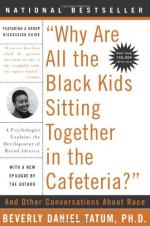
|
| Name: _________________________ | Period: ___________________ |
This test consists of 5 multiple choice questions, 5 short answer questions, and 10 short essay questions.
Multiple Choice Questions
1. Who signed the Civil Rights Act of 1968?
(a) James K. Polk.
(b) Ulysses S. Grant.
(c) Chester A. Arthur.
(d) Lyndon B. Johnson.
2. In Part II, Understanding Blackness in a White Context, Chapter 3, Tatum writes that she often opens race seminars with adults by asking them about what?
(a) Their first race-related memory.
(b) The degree of their parents' racism.
(c) If they have ever been a victim of racism.
(d) The most recent occurance of racism they have seen.
3. Beverly Daniel Tatum earned her PhD in clinical psychology from which university?
(a) Boston College.
(b) The University of Michigan.
(c) Hartford Seminary.
(d) The CUNY Graduate Center.
4. Tatum writes in Part II, Understanding Blackness in a White Context, Chapter 3 that children can notice race as young as how old?
(a) Four years.
(b) Seven years.
(c) Three years.
(d) Two years.
5. What university did Tatum attend and describe as a black school that had recently gone co-ed in Part II, Understanding Blackness in a White Context, Chapter 5, Racial Identity in Adulthood?
(a) The CUNY Graduate Center.
(b) Wesleyan University.
(c) Hartford Seminary.
(d) The University of Michigan.
Short Answer Questions
1. What word means to incorporate the cultural values, mores, motives, etc., of another or of a group, as through learning, socialization, or identification?
2. When was Erik Erikson born?
3. What is the second stage of William E. Cross, Jr.'s theory of Nigrescence?
4. When did the passage of the Thirteenth Amendment to the United States Constitution take place?
5. In Part I, A Definition of Terms, Chapter 1, Defining Racism, Tatum writes that in one course Tatum taught, a child denied that who could be black because she was "beautiful"?
Short Essay Questions
1. How does the author address the subject of slavery when dealing with children in Part II, Understanding Blackness in a White Context, Chapter 3, The Early Years?
2. How does the author relate personal identity to the surrounding social group in Part I, A Definition of Terms, Chapter 2, The Complexity of Identity?
3. How does Tatum describe the stages of racial identity for blacks in Part II, Understanding Blackness in a White Context, Chapter 5, Racial Identity in Adulthood?
4. What co-evolving processes construct personal identity according to the author in Part I, A Definition of Terms, Chapter 2, The Complexity of Identity?
5. How does Tatum describe her conception of herself regarding race in Part II, Understanding Blackness in a White Context, Chapter 5, Racial Identity in Adulthood?
6. How does the author define prejudice in Part I, A Definition of Terms, Chapter 1, Defining Racism? What does revealing prejudice require?
7. What two developmental stages does Tatum focus on in adolescent development of identity in Part II, Understanding Blackness in a White Context, Chapter 4, Identity Development in Adolescence?
8. How does the author describe reverse racism in Part I, A Definition of Terms, Chapter 1, Defining Racism?
9. What does the author write in Part II, Understanding Blackness in a White Context, Chapter 3, The Early Years that she begins adult seminars with asking?
10. How does the author describe the formation of an oppositional identity in adolescent blacks in Part II, Understanding Blackness in a White Context, Chapter 4, Identity Development in Adolescence?
|
This section contains 987 words (approx. 4 pages at 300 words per page) |

|




